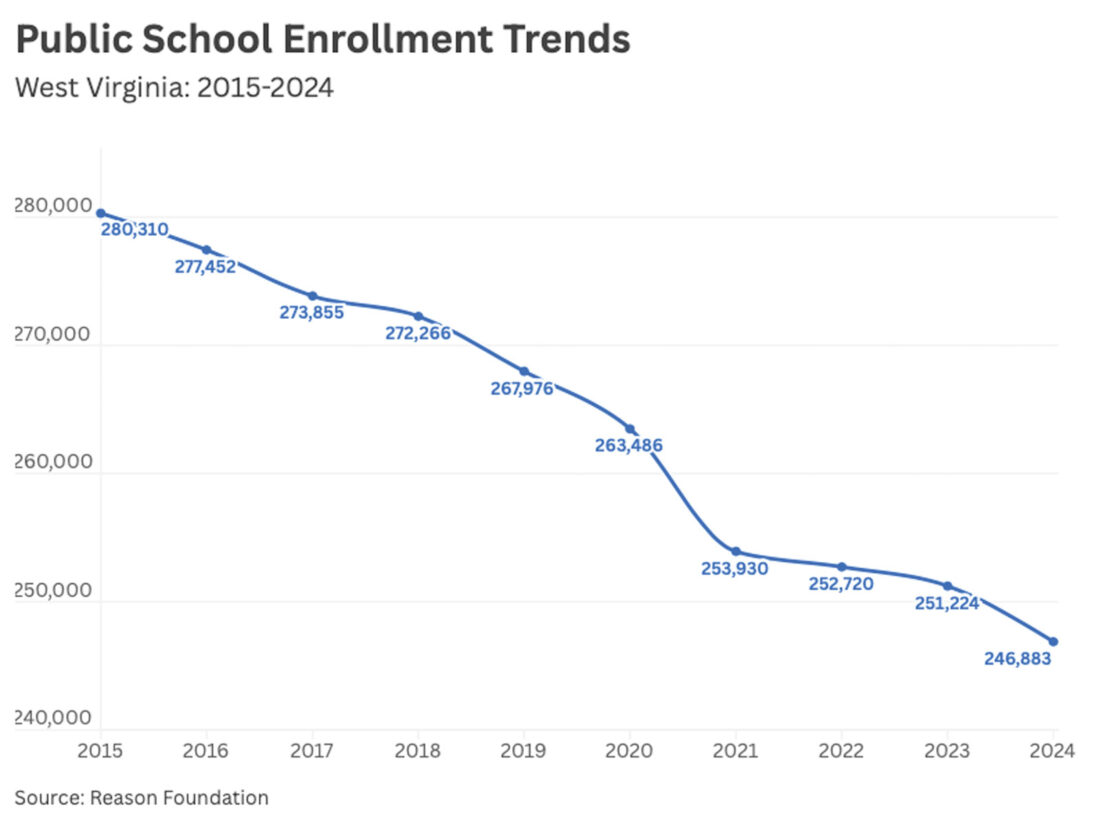West Virginia sees largest drops in student enrollment in the nation

CHARLESTON — Driven in part by the COVID-19 pandemic and continuing since, student enrollment at West Virginia’s public schools saw some of the largest drops in the nation.
According to a June report by the Reason Foundation, a libertarian public policy research non-profit, West Virginia was one of four states that saw its public school enrollment drop by more than 5% during a four-year period between fiscal years 2020 and 2024, overlapping with much of the COVID-19 pandemic.
West Virginia started fiscal year 2020 with 263,486 students enrolled in public schools, but that number dropped to 246,883, losing 16,603 students during that four-year period. During that same period, public school enrollment nationally fell by 1.28 million students, or 2.5%.
While some public school systems in other states saw small increases in enrollment in the most recent years since the start of the pandemic, West Virginia is not one of those states. The Reason Foundation cited information from the National Center for Education Statistics showing that West Virginia was one of three states with the largest public school enrollment declines between fiscal years 2023 and 2024, with a 1.7% enrollment decline.
According to the report’s authors, West Virginia’s enrollment decline was not solely due to COVID-19 and predated the pandemic.
“For some states, the pandemic aggravated existing declines in public school enrollment,” wrote Aaron Garth Smith and Jordan Campbell. “From the 2012 to 2020 fiscal years, states like New Hampshire (-7.6% drop in enrollment), West Virginia (-6.9%), and Illinois (-6.7%) lost considerable percentages of their public school student populations.”
West Virginia’s 55-county public school system has been struggling for a long time with decreases in student enrollment caused by overall population losses, fewer births, and an aging population. These enrollment decreases are now catching up to county school systems in the form of decreased property tax collections and reductions in funding from the state school aid formula, which is tied to county student enrollment.
County school systems rely on property taxes, bonds and levies, and funding through the complicated state school aid formula which is primarily based on student enrollment. The Department of Education finalizes student enrollment numbers every October, which then determines how much money county school systems get from the school aid formula the next school year.
There are other factors decreasing student enrollment, including the state’s new open enrollment program, the handful of public charter schools, the two statewide virtual charter schools, and the number of former public school students who have signed up for the Hope Scholarship education voucher program.
The Reason Foundation report is based, in part, on research by Thomas Dee, an economist and professor at Stanford University who studies student enrollment issues.
“We saw a historically unprecedented exodus from public schools during the pandemic, especially among students at the kindergarten and early grade levels,” Dee told the Stanford Report in a 2023, article. “We’ve begun to see the financial pressure this is putting on many districts, with discussions about closing under-enrolled schools and possibly laying off teachers. But there hasn’t been much focus on where these students went and what kind of learning environments they were experiencing.”
According to an essay for the Urban Institute, Dee presented data showing a 4.63% increase in the number of students in West Virginia attending a private school, from 11,248 in the fall of 2019 prior to the start of the pandemic to 11,769 in the fall of 2021.
The state public charter school pilot program was created by the Legislature in 2019, while the Hope Scholarship was created by lawmakers in 2021. The Legislature approved open enrollment in 2023.
During the previous school year, the West Virginia Board of Education had approved school closures and consolidations in Kanawha, Wood, Harrison, Randolph, Clay, Lincoln, Roane, and Wetzel counties.






